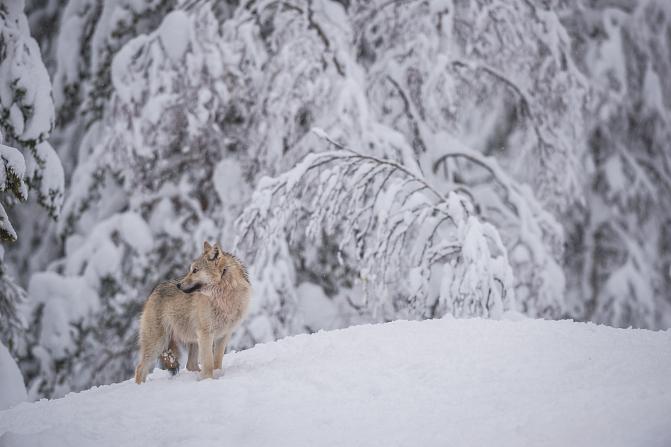Information plays an important role in societal dialogue and practical coexistence with wolves. Information about where to get help and support, and how to protect domestic animals, helps people cope in wolf territories.
Dialogue on wolves is emotional and coloured by various claims about wolves, politics and research. When flooded with information, it may be difficult to perceive what is true and up to date.
People have a thirst for information about wolves. Some 70 per cent of the adult population living south of the reindeer husbandry area say they have read at least one news article about wolves during the last year. This is unsurprising, as an average of 2,600 online news articles are published in Finland each year. This translates to at least 50 wolf-related news articles per week!
Goal:
Strengthening people’s engagement in the management and monitoring of matters related to wolves, providing people living in wolf regions with information and support, promoting a constructive dialogue with stakeholders, and integrating research data more closely into public dialogue.
Measures:
- The progress and results of the project were communicated regularly on the website and in social and conventional media channels, as well as in various other ways.
- The media monitor built in the project used AI to monitor and classify wolf-related news.
- Educational material presented large Finnish carnivores to children. Specialists from the Finnish Wildlife Agency and the Uusimaa district of the Finnish Association for Nature Conservation visited schools across Finland.
- Wolf events were held for media representatives and Members of Parliament.
- Lessons learned about coexistence with wolves in other countries were heard at an international seminar and were implemented in practice with Finnish stakeholders.
- The Uusimaa district of the Finnish Association for Nature Conservation held two public events about wolves in Western Uusimaa.
Results
The project was in the spotlight in wolf regions and cooperated with stakeholders
The project’s key stakeholders represented a diverse group of people living in wolf regions and the countryside, domestic animal farmers, hunters and nature conservationists. Extensive cooperation was carried out around different themes: hiking trips collecting DNA samples, joint patrols of the supervisory authorities, wolf-themed village and community events, workshops, international seminars, and remote meetings.
Specialists participated in various local and regional events, gave interviews to reporters, and answered various questions from citizens.
Social media acted as an important channel not only for communication but also for customer service and interaction. The project received many questions that were answered by specialists from several organisations. Answers to frequently asked questions were published online.
Of the adult population south of the reindeer husbandry area, 25 per cent knew the project by name in 2024 (Pellikka & Ala-Kurikka, 2024). An even larger percentage said they had read news or had otherwise heard more about the project’s themes. People living in wolf regions were more familiar with the project and its activities than people in other parts of the country.
Learning about Finland’s four large carnivores during school visits
The educational material on the bear, lynx, wolf and wolverine consisted of a teacher’s guide, brochures, videos, slideshows, posters and exercises. The material is openly available online. In addition, teacher’s guides and brochures for the identification of tracks were handed out to 283 schools. Based on feedback, teachers were satisfied with the material and spoke especially highly of the videos and the information about how to encounter large carnivores and identify their tracks.
During the school visits by planners from the Finnish Wildlife Agency and specialists from the Uusimaa district of the Finnish Association for Nature Conservation, children learned about the life, nutrition and distinctive features of large carnivores. Children had the opportunity to identify large carnivore tracks using a printed mat on a natural scale.
LIFE BOREALWOLF provided media representatives with perspectives and solutions
Coordinated by Metsähallitus, nine media events were held, both remotely and in person. Media representatives were invited once a year on a field trip to or near a wolf territory.
In 2019–2024, the project was mentioned by name in 944 news stories. This is equivalent to an average of three news stories a week. The project was not always mentioned, even if a news story covered the project’s themes or activities. This means that the themes have received broader coverage than is indicated by the number of times the project’s name has been seen or heard in media releases.
According to the media representatives who participated in the events, the LIFE BOREALWOLF project provided information, perspectives, new interviewees, meeting places and tangible solutions.
The project also built media monitoring tools to follow wolf-themed news and examine its content. The monitoring tool – the media monitor – helped separate wolf-related news from news in which the word “wolf” was mentioned in other contexts. The media monitor helped identify how wolves were mentioned in the news, and how often. Furthermore, it showed that the themes, publication dates and number of wolf-related news stories followed a similar pattern every year: most news was published during the snow cover in the winter.
Key figures
- More than 3,200 followers in social media accounts
- Project demonstrated to some 10,000 people at more than 240 events
- Educational material handed out to 283 schools
- 149 school groups of 2,681 pupils visited
- In 2019–2024, the project was mentioned by name in 944 news stories
- 30 media releases published
- 135 media representatives participated in media events
- A total of 66 participants from all major parties attended events organized for the Members of Parliament




